Can you use green or any colour pepper interchangeably? Does the hotness of some chile peppers act as a preservative?
This is an ‘advanced’ topic page examining such questions.
If you just need “how to” right now instead of the “whys and wherefores”, here’s canning plain peppers, here’s canning roasted peppers, and here’s an assortment of pepper canning recipes in general .
For the sake of clarity, this is about fresh peppers, the vegetable, not black or white (or pink or green) peppercorns, the spice. And for the purposes of discussing safety, the words “pepper” and “chile”, as in “chile pepper”, can be thought of interchangeably (though obviously not for flavour!)
Note also that “chili” is the meat and tomato dish; “chile” is the pepper.
See also: Dehydrating sweet peppers
- 1 Summary
- 2 Overview of home canned pickle product types
- 3 You can substitute any type or colour of pepper for another, safety-wise, in the same quantity
- 4 It is always safe to use less fresh pepper in a canning recipe
- 5 Skinning peppers
- 6 Freezing peppers first or plain canning first then using in relishes and pickled items?
- 7 How to keep peppers crisp after canning?
- 8 The heat of a pepper has no preservation effect
- 9 Does salt help preserve peppers?
- 10 Further reading
Summary
Peppers are a low-acid food. To can peppers plain, as is, you must pressure can them. To can them via water-bath (or steam canning), you add acidity to turn them into an acid-food product such as pickled peppers.
It doesn’t matter what colour or how hot peppers are. In terms of safety, they are all treated the same and can all be interchanged for each other in canning recipes, weight for weight.
Pressure-canned peppers will come out very soft. To maintain some crispness, you must instead use your peppers for a pickled product of some form.
Some peppers need to be skinned before canning, because their skins can go very tough and render the product you made unpleasant in people’s mouths.
Overview of home canned pickle product types
Penn State Extension breaks the two broad types of pepper products (plain and pickled) into five different product ranges.
The main types of Pepper products include :
- Regular plain: made with bell, pimiento, chili, and jalapeño peppers [Ed: packed in plain water and pressure-canned]
- Sweet pickled: made with banana, bell, Hungarian, and pimiento peppers
- Hot pickled: made with chili and jalapeño peppers
- Marinated: normally made with sweet red, yellow, and green peppers [Ed: marinating solution will include vinegar]
- Pickled pepper relish: normally made with sweet red, yellow, and green peppers.
Process jars of non-pickled peppers in a pressure canner or jars of pickled peppers in a boiling water canner ” [1] Laborde, Luke. Let’s Preserve: Peppers. Penn State Extension. Code UK128 4/15pod. 2013.
Whatever tested recipe with its accompanying method you use, it will have been designed to take certain precautions because peppers are low acid. New Mexico State University says:
Because chiles are naturally low in acid, canning them requires special precautions that differ from those for canning high-acid foods. In particular, canning procedures must prevent the growth of microorganisms.” [2] Nancy C. Flores and Cindy Schlenker Davies. Canning Green Chile. College of Agricultural, Consumer and Environmental Sciences, New Mexico State University. Guide E-308. Revised November 2015. Accessed June 2016.
Linda Harris of the University of California says,
Because they are low-acid vegetables, peppers must always be canned in a pressure canner if they are not pickled.” [3]Harris, Linda J. Peppers: Safe Methods to store, Preserve and Enjoy. University of California. Division of Agriculture and Natural Resources. Publication 8004. 1998. Page 4.
Lisa McKee from New Mexico State says,
Green chile is naturally low in acidity and should be pressure processed when canned alone. However, combining green chile with acidic ingredients like fruits and juices to make sweet spreads yields products that are safe for water-bath canning.” [4] McKee, Lisa. Home Canned Sweet Spreads Made with Green Chile. College of Agricultural, Consumer and Environmental Sciences, New Mexico State University. Guide E-336. Revised November 2015. Accessed June 2016.
You can substitute any type or colour of pepper for another, safety-wise, in the same quantity
Peppers are completely interchangeable in terms of colour and heat. Just always swap like amount for like amount. It’s okay to use less pepper than a recipe calls for, but never more.
Provided you follow that rule, swapping fresh peppers is up to you, but bear in mind that swapping peppers could affect the taste or otherwise quality of the product. In that regard, as a cook, you’re in charge and fully responsible.
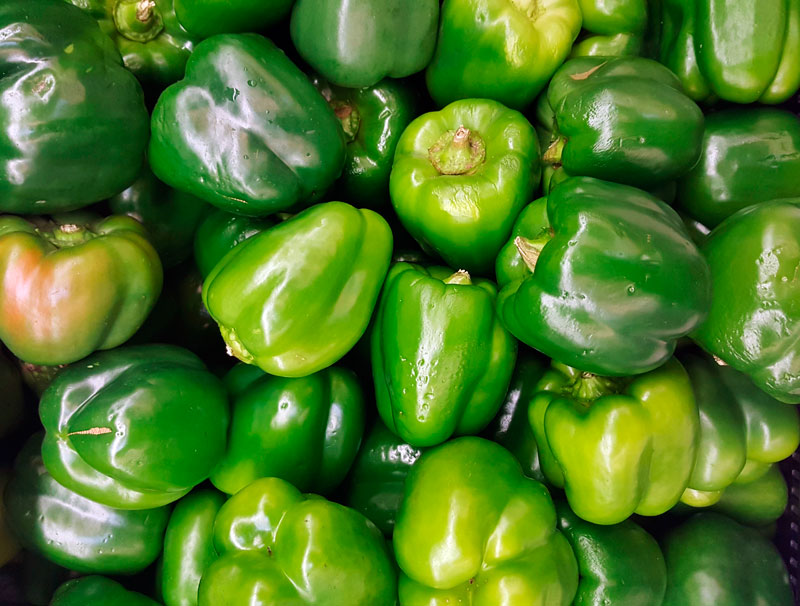
Green bell peppers, mild, and tending to sweet. Brett Hondow / Pixabay.com / 2016 / CC0 1.0
Example 1: Changing the intensity of the pepper / chile
A canning recipe will usually indicate a preferred heat type of pepper for a recipe, either mild, medium or hot.
For instance, the USDA’s Easy Hot Sauce (USDA Complete 2015, page 3-16) suggests 1 ½ cups (225 g / 8 oz) of seeded, chopped [fresh] Serrano peppers. That would yield a somewhat hot hot sauce, but not one that is crazy over the moon hot.
You could swap in any other type of fresh chile or pepper, provided that you did not use more than the amount of 1 ½ cups (225 g / 8 oz) of seeded, chopped pepper or chile.
If you were to use Scotch bonnet or habanero or ghost chile peppers, you’d have a blazing hot hot sauce that you’d have to serve with caution.
If you were to use bell peppers, the sauce would have no kick to it at all, and in fact, might be tasteless and pointless.
Here’s what the experts say about swapping pepper heats
Washington State advises to not increase the total amount of peppers in any recipe. However, you may substitute one type of pepper for another.
You may substitute bell peppers for some or all of the long green chiles. Canned chiles may be used in place of fresh. … Do not increase the total amount of peppers in any recipe. However, you may substitute one type of pepper for another.” [5]Hillers, Val and Richard Dougherty. Salsa Recipes for Canning. Washington State University Cooperative Extension. Page 1. Accessed January 2015.
Wisconsin says,
Don’t add more hot peppers [Ed: as in, ‘additional’ hot], as that will decrease acidity. Instead, swap out an amount of regular peppers and replace that amount with hot peppers.” [6] Canning Tomatoes & Tomato Products. Powerpoint Presentation. Lunch & Learn, 23 July 2012. University of Wisconsin Extension. Accessed March 2015.
The University of Kentucky Extension Service says,
One variety of pepper can be substituted for another in the same amount (for example, bell peppers for hot peppers to make a milder salsa.) [7]Bastin, Sandra and Debbie Clouthier. Home Canning Salsa. University of Kentucky Extension Service. FCS3-581. Feb 2014. Page 1. Accessed June 2016.
Linda Harris, from the University of California, says
It is possible to adjust the intensity of pickled peppers by using all hot peppers or blending the hot peppers with sweet bell peppers. However don’t change the total amount of peppers required in the recipe. ” [8]Harris, Linda J. Peppers: Safe Methods to store, Preserve and Enjoy. University of California. Division of Agriculture and Natural Resources. Publication 8004. 1998. Page 3.
Example 2: Changing the colour of peppers used

Orange bell peppers. Skeeze/ Pixabay.com / 2013 / CC0 1.0
A canning recipe will often indicate, directly or indirectly, a preferred colour of pepper.
For instance, Ball / Bernardin’s ‘Cucumber Relish‘ wants you to use half green pepper, half red pepper.
The different colours in this case would add visual interest to the result, and no one has ever denied that visual interest is a big part of good food. The red peppers, in addition to providing colour, would provide a tidge of sweetness, because bell peppers sweeten as they ripen.
If you were making this relish in winter with cucumbers you got at a good price at a market, but, the cost of red bell peppers had gone through the roof, you might be wise to use all green pepper instead.
The recipe happens to call for 1.5 kg (8 cups) of seeded, chopped bell pepper: half red, half green. You could just use 1.5 kg (8 cups) of all green if the red were too expensive. If you got a super deal on red peppers, then you could use all red instead of green.
You’d also be fine safety-wise using less pepper overall, though the consistency, texture and yield of the recipe would change.
Here’s what the experts say about swapping pepper colours
For pressure canning plain peppers, the colour is irrelevant :”Select firm yellow, green, or red peppers.” [9] United States Department of Agriculture (USDA). Complete guide to home canning. Agriculture information bulletin No. 539. 2015. Page 4-15.
Example 3: Changing the size of peppers used
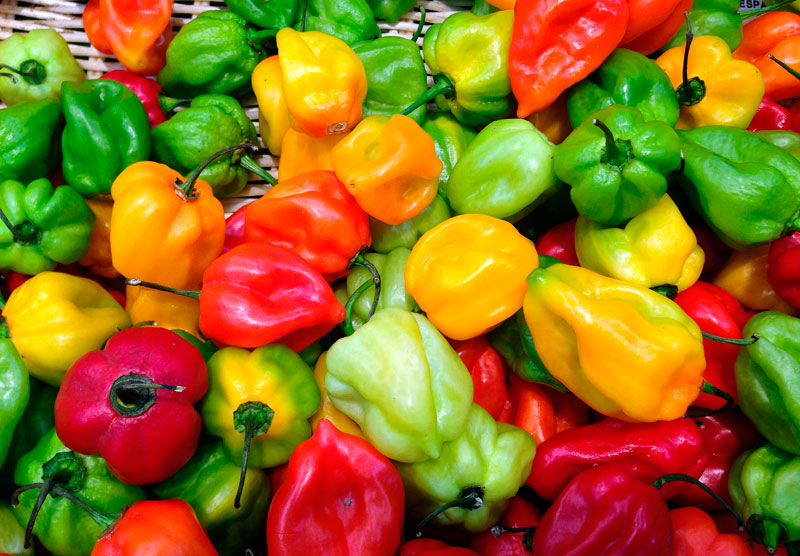
Habenero chlie peppers. Jacqueline Macou / Pixabay.com / 2015 / CC0 1.0
This is the one caution about swapping peppers that you need to watch for: not swapping a given number of small peppers for a given number of large ones.
For instance, the Canadian Living ‘Yellow Salsa’ recipe calls for 6 habanero peppers.
Habanero peppers are small, and don’t weigh a lot.
Say you felt that would be way too hot for your audience, and wanted to use sweet, mild bell pepper instead.
You have to figure out what the weight or volume measurement of 6 seeded and chopped habanero would be, and use the equivalent prepped weight or volume measurement of bell pepper. What you would NOT do is use 6 whole bell peppers. The weight of 6 bell peppers (or volume measurement after seeding and chopping) would be way beyond that of the 6 habanero. Whole for whole is not an equivalent in this case because the physical size is not equivalent.
Provided you do use a weight / volume equivalent swap, instead of a ‘size’ swap, then as a cook the flavour / heat decision there is in your ball court.
Here’s what the experts say about changing pepper sizes
The USDA Complete Guide says,
Do not substitute the same number of whole peppers of a large size for the number of peppers of a smaller size (for example, do not use 6 bell peppers or long chiles in place of 6 jalapeños or serranos). This will result in changing the final acidity of the mixture and potentially unsafe canned salsa. [10]United States Department of Agriculture (USDA). Complete guide to home canning. Agriculture information bulletin No. 539. 2015. Page 3-20.
Karen Balkeslee from Kansas State concurs. She says,
It is important not to increase the total amount (pounds or cups) of peppers or onions in any recipe. Also, do not substitute the same number of whole large peppers for the same number of smaller peppers. This will cause a change in acid content which could be unsafe. If substituting hot and mild peppers, any kind of pepper can be used, just use the same weight stated in the recipe. ” [11] Balkeslee, Karen. Sensational Salsa. Kansas State University Research and Extension. April 2007. Page 2.
It is always safe to use less fresh pepper in a canning recipe
It’s always safe to use less fresh pepper in a canning recipe than what is called for.
The concern safety-wise about using more is that, as a low-acid vegetable, using more could tip the acidity safety-line of the recipe too low.
Quality-wise, using less will only affect the consistency, or flavour, or yield.
For instance, if you are pickling green tomatoes and the recipe calls for one slice of green pepper per jar, and you don’t have that to hand, it’s fine to omit it: it’s there for flavour and piquancy.
If a relish recipe calls for 8 green bell peppers and you only have 6, it’s fine to just use those 6 — but don’t increase something else like onion, etc in compensation. Being two peppers short has no safety implications. It may, however, affect consistency or yield of the relish, or make the taste a bit less zippy.
Barb Ingham, of the University of Wisconsin Extension says:
You may reduce the amount of low-acid ingredients such as onion, celery, or green peppers in a tested salsa recipe.” [12]Ingham, Barbara. Home Canning: Can I Make Substitutions Safely? University of Wisconsin Extension. 23 June 2015. Accessed June 2016 at https://bayfield.uwex.edu/2015/06/23/play-it-safe-changes-and-substitutions-to-home-food-processing-recipes/.
Skinning peppers
Long Green / New Mexico Chiles
When you see people referring to long green chiles, or New Mexico green chiles, these are the types of chiles with tough skins that must be peeled.
New Mexico / Long Green is actually a catch-all name for several different varieties grown in the American south-west; the best known individual variety names perhaps being Anahein and NuMex. For more information see, https://www.cooksinfo.com/new-mexico-chile-peppers
Many varieties of chiles are grown to be used in small quantities to be used as flavouring agents in dishes; this grouping of chiles are grown to actually be used as a vegetable per se in dishes, forming a substantial part of those dishes.
As far as the New Mexico State University Extension Service is concerned, peppers is all about chile peppers, and chiles is all about their home-grown group of New Mexico long green chiles, so when they refer to chiles, that is what they will mean.
They say, “The tough outer skin must be removed from chiles.” [13] Nancy C. Flores and Cindy Schlenker Davies. Canning Green Chile. College of Agricultural, Consumer and Environmental Sciences, New Mexico State University. Guide E-308. Revised November 2015. Accessed June 2016.
It’s important to understand that, because people who have long dealt with other soft-skinned chiles may find themselves bewildered at the insistence on peeling them.
Some people say that if you will be finely chopping those long green New Mexico chiles, that you don’t need to go through the peeling hoopla:
The University of Minnesota says,
The skin of the long green chilies is removed by heating the peppers. If you finely chop the peppers, you do not need to remove the skin.” [14] Burtness, Carol Ann. Canning Tomato-Based Salsa Safely. University of Minnesota Extension Service. 2014. Accessed June 2016 at https://www.extension.umn.edu/food/food-safety/preserving/tomatoes-salsa/canning-tomato-based-salsa-safely/.
The USDA says,
Usually when peppers are finely chopped in a salsa, they do not need to be peeled. However, many recipes say to peel the recipes, and the skin of long green chiles in particular may be tough after canning. [15] United States Department of Agriculture (USDA). Complete guide to home canning. Agriculture information bulletin No. 539. 2015. Page 3-20.
Other peppers
The National Center for Home Food Preservation advises on many recipes, “The jalapeño peppers do not need to be peeled.” [16] National Center for Home Food Preservation. Tomato Taco Sauce. Accessed June 2016.
If you wish to can other, ‘non New Mexico’ peppers plainly (which means pressure canning, to reconfirm), you have the choice of peeling them or not via two procedures.
- There is a USDA procedure, which has you roast and peel them;
- There is a Ball and Bernardin procedure, which does not require peeling.
To make your roasting and peeling life a bit easier and faster, you can get pepper roasting racks that handle from 12 to 36 peppers at once, and will work either on outdoor grills or in ovens. Some have different size slots for different size peppers. Below is a sample of one on Amazon (as of June 2016). By searching you can find other models; all inexpensive.
Freezing peppers first or plain canning first then using in relishes and pickled items?
Peppers of any type that have been frozen won’t be crisp enough for pickling or even crisp enough for relishes or salsas. The freezing will have caused the water in them to expand and burst through the cell structures.
Plain pressure canned peppers are the same, except it will have been the heat that caused the water to burst the cell structures.
Peppers lose their crispness when frozen and thawed. Frozen peppers are useful in cooked dishes where texture is not important.” [17] Harris, Linda J. Peppers: Safe Methods to store, Preserve and Enjoy. University of California. Division of Agriculture and Natural Resources. Publication 8004. 1998. Page 1.
You can of course use both frozen (thawed) and plain canned peppers in many ordinary cooking dishes such as risotto, soups, stews, casseroles, etc.
They can also used in other canning recipes: products such as pressure canned chili or pressure canned sloppy joes, where the taste of peppers is desirable but the crisp texture is not. You would just need to work out what the equivalent of your frozen / canned peppers would be to the fresh that is usually called for in such recipes.
How to keep peppers crisp after canning?
If you want peppers with any type of crispness after canning, you are looking at a pickled product.
All types of peppers can be pickled. They are low in acid and must be properly acidified if they are to be safely processed in a water bath canner. The lower temperatures used in pickling help to preserve the crispness of the peppers.” [18] Harris, Linda J. Peppers: Safe Methods to store, Preserve and Enjoy. University of California. Division of Agriculture and Natural Resources. Publication 8004. 1998. Page 1.
To help them stay even crisper, you may wish to even try adding some Pickle Crisp from Ball / Bernardin.
The heat of a pepper has no preservation effect
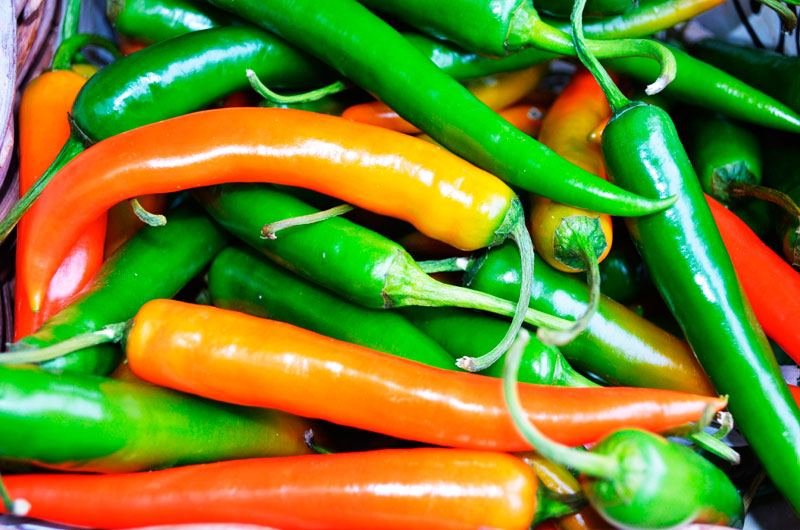
Hot chiles. PublicDomainPictures / Pixabay.com / 2011 / CC0 1.0
The heat of peppers (the amount of ‘Capsaicin’ in them) is measured on the “Scoville” scale in Scoville units. Heat here refers to “spiciness”, rather than temperature.
The heat of a pepper has zero preservative effect as far as home canning goes. According to Linda Harris at the University of California,
It is a common misconception that the hotter the pepper, the more acidic it is. The hotness of a pepper depends on the amount of capsaicin it contains and not on the level of acidity. All peppers are classified as low-acid foods and have a pH of 4.8 to 6.0 depending on maturity and variety.” [19]Harris, Linda J. Peppers: Safe Methods to store, Preserve and Enjoy. University of California. Division of Agriculture and Natural Resources. Publication 8004. 1998. Page 1.
Does salt help preserve peppers?
Salt has zero preservative effect in home canned peppers.
Linda Harris from the University of California says,
The salt in pickled peppers is used for seasoning and can be safely omitted by those on sodium-restricted diets.” [20]Harris, Linda J. Peppers: Safe Methods to store, Preserve and Enjoy. University of California. Division of Agriculture and Natural Resources. Publication 8004. 1998. Page 3.
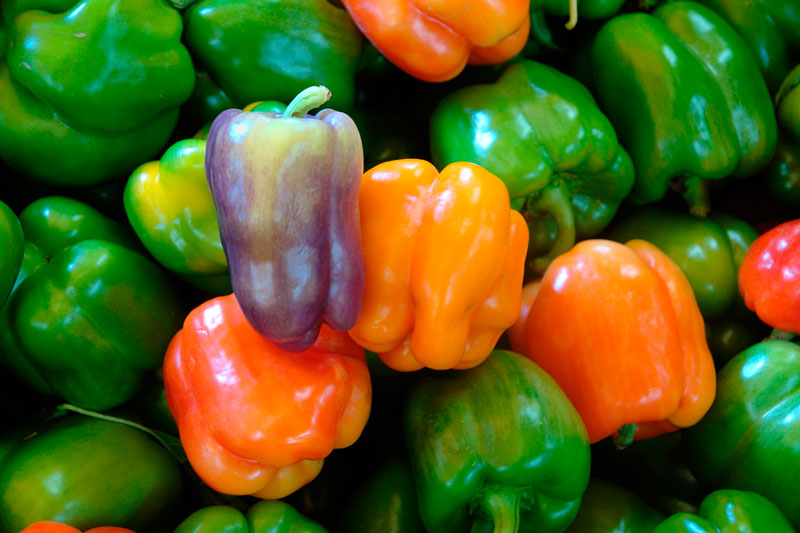
Various coloured bell peppers. LoveToTakePhotos / Pixabay.com / 2015 / CC0 1.0
Further reading
- Jalapeno peppers: plain versus pickled
- Canning plain jalapenos
- Canning pickled jalapenos
- Canning plain hot peppers
- Canning roasted mild peppers
- Canning plain mild peppers
- Linda J Harris. Peppers: Safe Methods to Store, Preserve, & Enjoy. University of California, Division of Agriculture and Natural Resources. Publication 8004. 1998.
References

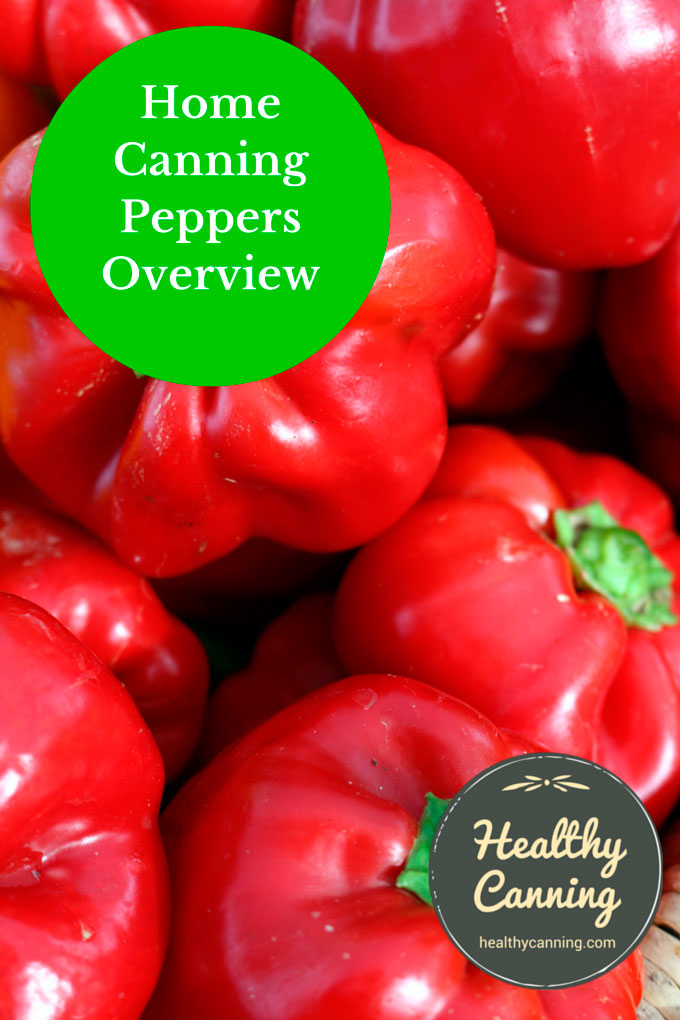
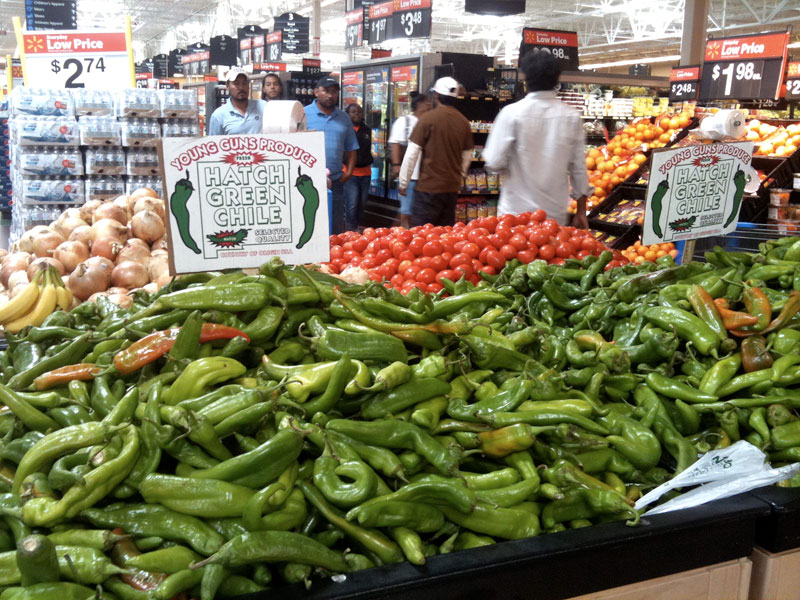


Holli Ratzloff
It would also be a good idea to know the types of peppers that you are looking for before you start shopping. There are many types of chilies out there, and they all have different flavors, depending on where they were grown and what season they are, so it is a good idea to do your research before you start cooking.